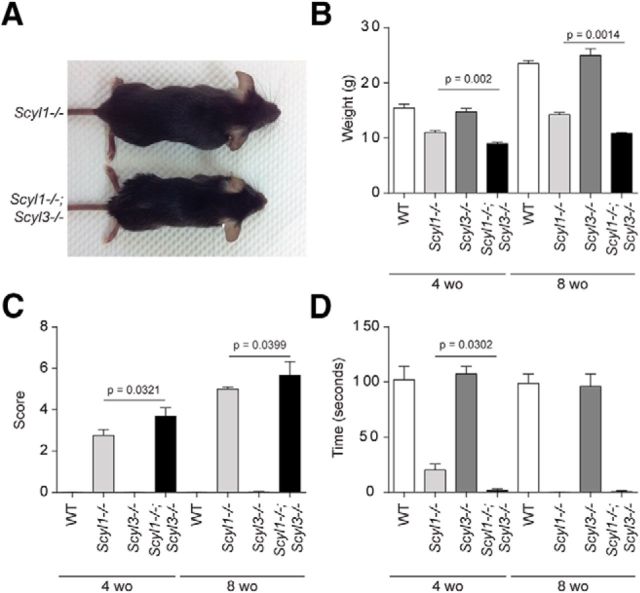Figure 5.
Scyl3 deficiency exacerbates growth and motor phenotypes associated with the absence of Scyl1. A, Representative photograph of 8-week-old (wo) Scyl1−/− and Scyl1−/−;Scyl3−/− male littermates showing size differences between these genotypes. B, Body weight of 4- and 8-week-old WT (4-week-old mice, n = 22; 8-week-old mice, n = 13), Scyl1−/− (4-week-old mice, n = 22; 8-week-old mice, n = 15), Scyl3−/− (4-week-old mice, n = 12; 8-week-old mice, n = 8), and Scyl1−/−;Scyl3−/− (4-week-old mice, n = 8; 8-week-old mice, n = 3) males. Data are expressed as mean ± SEM. P values, determined by one-tailed Student's t test, are indicated on the graph. C, Disease progression in 4- and 8-week-old WT (4-week-old mice, n = 11; 8-week-old mice, n = 11), Scyl1−/− (4-week-old mice, n = 17; 8-week-old mice, n = 14), Scyl3−/− (4-week-old mice, n = 12; 8-week-old mice, n = 4), and Scyl1−/−;Scyl3−/− (4-week-old mice, n = 13; 8-week-old mice, n = 3) mice. Disease progression in mice was assessed by using an objective grading system as described in Materials and Methods. Data are expressed as mean ± SEM. P values, determined by the one-tailed Student's t test, are indicated on the graph. D, Motor defects in 4- and 8-week-old WT (4-week-old mice, n = 10; 8-week-old mice, n = 12), Scyl1−/− (4-week-old mice, n = 29; 8-week-old mice, n = 12), Scyl3−/− (4-week-old mice, n = 16; 8-week-old mice, n = 12) and Scyl1−/−;Scyl3−/− mice (4-week-old mice, n = 9; 8-week-old mice, n = 3). The inverted grid test was performed on 4- and 8-week-old mice as described in Materials and Methods. Data are expressed as mean ± SEM. P values, determined by the one-tailed Student's t test, are indicated on the graph.

